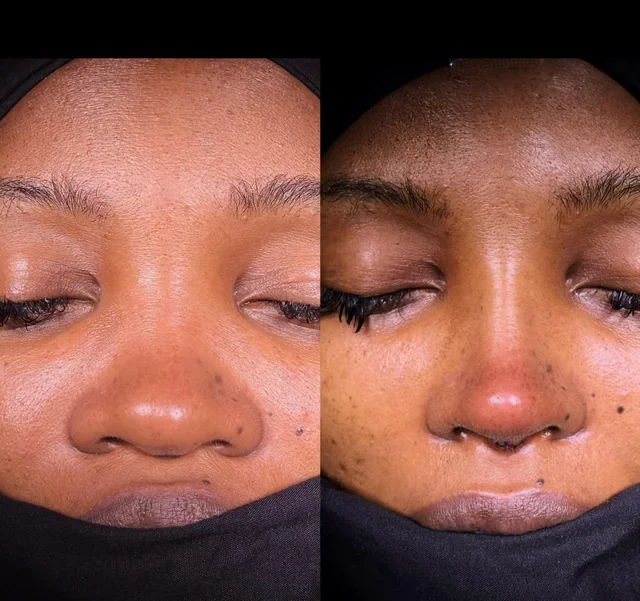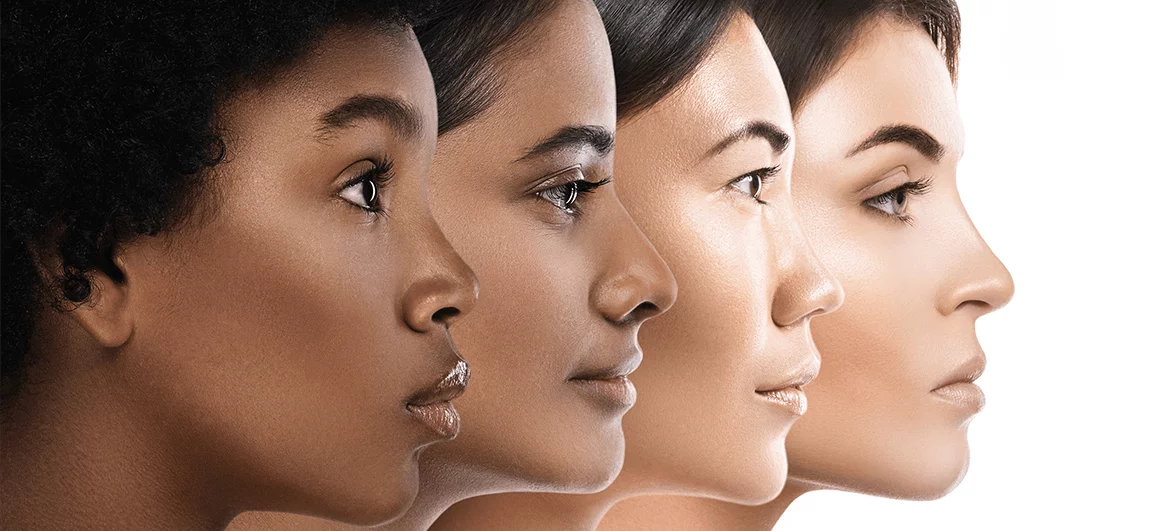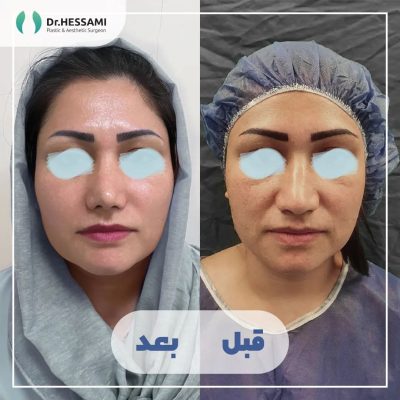Ethnic Rhinoplasty in Iran
Ethnic rhinoplasty in Iran refers to a type of rhinoplasty, or nose surgery, that is specifically tailored to individuals from different ethnic backgrounds. The goal of ethnic rhinoplasty is to improve the aesthetic appearance of the nose while respecting and preserving the patient’s unique ethnic characteristics.
Ethnic Rhinoplasty in Iran is a type of plastic surgery that is performed in order to preserve or improve the characteristics of the nose associated with a certain ethnicity of people. The purpose of this type of surgery is to change the shape of the nose without destroying the ethnic and cultural features. In other words, the surgeon tries to improve the appearance of the nose, while at the same time preserving signs of the patient’s heritage and ethnic background.
Key Considerations in Ethnic Rhinoplasty in Iran
Anatomical Differences
Different ethnic groups may have distinct nasal features such as skin thickness, nasal bone structure, and cartilage shape. For example, African and Asian patients typically have thicker skin and weaker cartilage compared to Caucasian patients, which can affect the surgical approach and techniques used.
Aesthetic Preferences
Beauty standards and aesthetic preferences can vary widely across different cultures and ethnicities. Surgeons must be aware of these nuances to ensure that the results meet the patient’s expectations and are harmonious with their overall facial features.
Preserving Ethnic Identity
Many patients seeking ethnic rhinoplasty do not want to erase their ethnic identity; instead, they want to enhance their features in a way that remains true to their cultural background. This requires a surgeon with a nuanced understanding of how to make changes that are subtle and culturally appropriate.
Technical Expertise
Ethnic rhinoplasty can be more challenging due to the unique features associated with different ethnic noses. Surgeons need to have specialized training and experience to handle the intricate details of the procedure.
This type of surgery can include changes in the size, shape and even the angle of the nose. Plastic surgeons who specialize in this field must have a deep knowledge and understanding of the anatomical and aesthetic variation of the nose in different races and cultures to ensure that the surgical results both match the patient’s wishes and preserve the ethnic characteristics.
Things that may be considered in ethnic rhinoplasty include:
– Maintaining the normal width and height of the nose
– Adjusting the tip of the nose to create more balance in the face
– Strengthening or reducing the bridge of the nose
– Maintaining or improving the respiratory function of the nose
Because each person is unique, careful consultation with the surgeon before surgery is critical to ensure that the surgical goals and patient expectations are well understood and can be realistically met.
If you want to operate in Tehran, Dr Hessami, click the button below and follow the stepsStart your therapeutic journey
African ethnic nose job
African Ethnic Rhinoplasty is a type of rhinoplasty that is specially designed for people of African descent. This type of surgery is performed due to the special anatomical and aesthetic characteristics of the nose of African descent people, which may be different from other types of noses. Nasal characteristics of people of African descent can include thicker skin, softer cartilage, and a wider and shorter nose.
In African Ethnic Rhinoplasty, surgeons seek to create balance and harmony in the face, while preserving ethnic features and avoiding drastic changes that may cause the patient to lose their ethnic identity. This type of surgery may include:
Narrowing the nasal bones to reduce the overall width of the nose.
– Shrinking the nostrils to create more balance in the face.
– Strengthening the cartilage of the tip of the nose to create a more specific shape and a better profile.
– Raising the bridge of the nose to strengthen the profile.
– Reducing or correcting the tip of the nose to change its shape and size.

African ethnic rhinoplasty, like any other type of cosmetic surgery, should be performed by experienced and specialized surgeons who have a deep understanding of the cultural and aesthetic characteristics of each ethnic group. Also, it is important that patients have detailed consultations before surgery to discuss their goals and realistic expectations and that the surgeon can provide an appropriate and personalized surgical plan.
Asian ethnic nose job
Asian Rhinoplasty is a special type of rhinoplasty that considers the characteristics of Asian ethnicities. Unlike standard rhinoplasty, which may focus more on Western aesthetic principles, ethnic Asian rhinoplasty seeks to preserve the natural and cultural characteristics of Asian patients.
Asian people may have the following characteristics that should be considered in rhinoplasty:
– Relatively thicker nasal skin
– Lower or less prominent nasal bridge
– Softer and less defined nasal tip cartilage
– Rounder and wider nostrils
In ethnic Asian rhinoplasty, changes that are usually performed can include the following:
– Increasing the height of the bridge of the nose: this work is usually done using a prosthesis or tissues removed from the patient’s own body (such as cartilage taken from another part of the body).
– Strengthening and repairing the structure of the tip of the nose: To improve the shape and definition of the tip of the nose, cartilage may be used to create a stronger structure.
– Narrowing the nostrils: to create balance and harmony with other parts of the face.
– Correction of the angle between the upper lip and the lower nose: it may be done to create a more natural and proportionate appearance.

Like any cosmetic surgery, ethnic Asian rhinoplasty should be performed by experienced and skilled surgeons in this field. The surgeon must have the ability to understand and respect the different cultural and aesthetic characteristics of each person. A detailed consultation with the surgeon before the operation is necessary to determine realistic goals and plan the surgery accurately.
Middle Eastern ethnic nose job
Middle Eastern rhinoplasty refers to a set of rhinoplasty techniques that are specially designed to meet the needs and preserve the specific aesthetic characteristics of people of Middle Eastern ethnicity.
Middle Eastern people may have the following features in their nose that should be considered in rhinoplasty:
– Thicker nasal skin, which may have an effect on the final result of the surgery.
– The bridge of the nose with a variable height, sometimes with a definite arch or ridge.
– The cartilage of the tip of the nose, which may be weak and needs to be strengthened.
– Wider nose that may need narrowing.
In ethnic Middle Eastern rhinoplasty, the changes that are usually performed can include the following:
– Reduction of the bony prominence of the bridge of the nose (if present): This is usually done to create a flatter profile.
Strengthening and repairing the structure of the tip of the nose: This can help improve the shape and definition of the tip of the nose.
– Narrowing of the nose: which involves changing the shape of the bones and soft tissues to achieve a better fit with other facial features.
– Skin correction: Sometimes it is necessary to make adjustments to the skin of the nose so that the results of the surgery are well visible, especially if the skin is thick.
Like other types of ethnic surgeries, it is important that the surgeon has sufficient knowledge about the anatomical and aesthetic features specific to the Middle Eastern ethnicity and can maintain balance and harmony in the patient’s face. Also, the patient’s culture and expectations regarding surgical outcomes should be respected.
Detailed consultation with the surgeon before performing the operation is essential so that the therapists and the surgeon can have realistic expectations and a detailed planning for the surgery can be done. Choosing a skilled and experienced surgeon in ethnic-specific surgeries can help ensure optimal results.
Ethnic rhinoplasty is a type of rhinoplasty or rhinoplasty that is specifically designed for people of different races. The purpose of ethnic rhinoplasty is to improve the aesthetic appearance of the nose by observing and preserving the unique ethnic characteristics of the patient.
Common Goals of Ethnic Rhinoplasty
– Reshaping the Nasal Tip: Refining the tip of the nose to create a more defined appearance while maintaining appropriate proportions with the rest of the facial features.
– Nasal Bridge Alterations: Building up or reducing the nasal bridge to achieve a desired profile without compromising the natural appearance.
– Nostril Reshaping: Adjusting the size and shape of the nostrils to be more balanced with the new nasal structure.
– Improving Nasal Function: In some cases, breathing difficulties caused by structural abnormalities can be addressed during the rhinoplasty procedure.
Choosing a Surgeon for Ethnic Rhinoplasty
When considering ethnic rhinoplasty, it’s crucial to choose a surgeon who is not only skilled in rhinoplasty but also has experience with a diverse range of patients. They should have a portfolio demonstrating their work on individuals with similar ethnic features to the patient. Communication is also key; the patient should feel comfortable discussing their goals and concerns with the surgeon to ensure a mutual understanding of the desired outcome.
Recovery and Results
Recovery from ethnic rhinoplasty generally follows the same course as standard rhinoplasty procedures. Patients can expect swelling and bruising for the first few weeks, and it may take up to a year for the final shape of the nose to fully settle.
Like all surgical procedures, ethnic rhinoplasty carries risks, and potential patients should be thoroughly informed about these before deciding to undergo surgery. It is important to have realistic expectations and to understand that while changes can be significant, the goal is enhancement, not perfection.
Cartilage in ethnic rhinoplasty
Cartilage plays a crucial role in ethnic rhinoplasty, a specialized form of rhinoplasty that addresses the unique aesthetic and functional concerns of non-Caucasian patients. Here’s an overview of the significance of cartilage in ethnic rhinoplasty:
1. Structural Support:
Cartilage provides structural support to the nose, maintaining its shape and definition. In ethnic rhinoplasty, cartilage is often used to reinforce and strengthen the nasal framework, especially in cases where the patient desires a more prominent or defined nasal bridge.
2. Tip Projection and Definition:
The nasal tip is a common area of concern in ethnic rhinoplasty. Cartilage grafts can be used to project and define the nasal tip, creating a more aesthetically pleasing appearance. This is particularly important for patients with a broad or flat nasal tip.
3. Alar Contouring:
The alar cartilages, located on the sides of the nostrils, play a significant role in determining the shape and width of the nostrils. In ethnic rhinoplasty, cartilage grafts can be used to refine the alar contours, creating a more balanced and aesthetically pleasing appearance.
4. Dorsal Augmentation:
Dorsal augmentation, also known as bridge augmentation, involves increasing the height and definition of the nasal bridge. Cartilage grafts are commonly used for this purpose, as they provide a natural and long-lasting augmentation.
5. Nasal Lengthening:
In cases where the patient desires a longer nose, cartilage grafts can be used to extend the nasal length. This is achieved by placing cartilage grafts along the nasal dorsum and tip, creating a more balanced and harmonious facial profile.
6. Saddle Nose Correction:
Saddle nose deformity, characterized by a depressed nasal bridge, can be corrected using cartilage grafts. The grafts are placed along the nasal dorsum to restore the bridge’s height and definition.
7. Revision Rhinoplasty:
In revision rhinoplasty, cartilage grafts are often used to address complications or unsatisfactory results from a previous rhinoplasty procedure. Cartilage grafts can help improve the nasal shape, correct irregularities, and restore nasal function.
8. Ethnic Considerations:
Ethnic rhinoplasty takes into account the unique anatomical features and aesthetic preferences of non-Caucasian patients. Cartilage grafts can be customized to achieve results that are harmonious with the patient’s facial features and ethnic background.
It’s important to note that the use of cartilage in ethnic rhinoplasty should be carefully planned and executed by a skilled and experienced rhinoplasty surgeon. The surgeon must possess a deep understanding of the patient’s aesthetic goals, ethnic considerations, and the intricacies of nasal anatomy to achieve optimal results.
Recovery after ethnic rhinoplasty
Recovery after ethnic rhinoplasty typically follows a similar timeline to that of traditional rhinoplasty, with some variations depending on the extent of the surgery and the individual’s healing process. Here’s a general overview of what to expect during the recovery period:
Immediately After Surgery:
You will likely experience some pain, swelling, and bruising around the nose and eyes.
A nasal splint or cast may be placed to protect the nose and maintain its new shape.
Nasal packing may be used to control bleeding and support the nasal structure.
First Week:
Swelling and bruising will gradually subside, but it may take several weeks or even months for the final results to become fully apparent.
You may experience nasal congestion and difficulty breathing through the nose.
Gentle saline rinses and nasal sprays can help keep the nasal passages moist and promote healing.
Avoid strenuous activity and excessive nose blowing.
Second Week:
The nasal splint or cast is typically removed, and stitches are dissolved or removed.
Swelling and bruising continue to improve, and breathing through the nose becomes easier.
You may be able to return to work or school, but it’s important to avoid strenuous activity and contact sports.
Months 3-6:
The majority of swelling and bruising should have resolved by this point.
The final results of your rhinoplasty will become more evident as the healing process continues.
You should be able to resume all normal activities, including exercise and contact sports.
Long-Term Recovery:
It can take up to a year or more for the final results of rhinoplasty to fully stabilize.
Some swelling and minor irregularities may persist for several months, but these should gradually diminish over time.
Regular follow-up appointments with your surgeon are essential to monitor the healing process and address any concerns.
It’s important to note that everyone’s healing process is unique, and the recovery timeline may vary from person to person. It’s crucial to follow your surgeon’s instructions carefully and attend all scheduled follow-up appointments to ensure a smooth and successful recovery.




